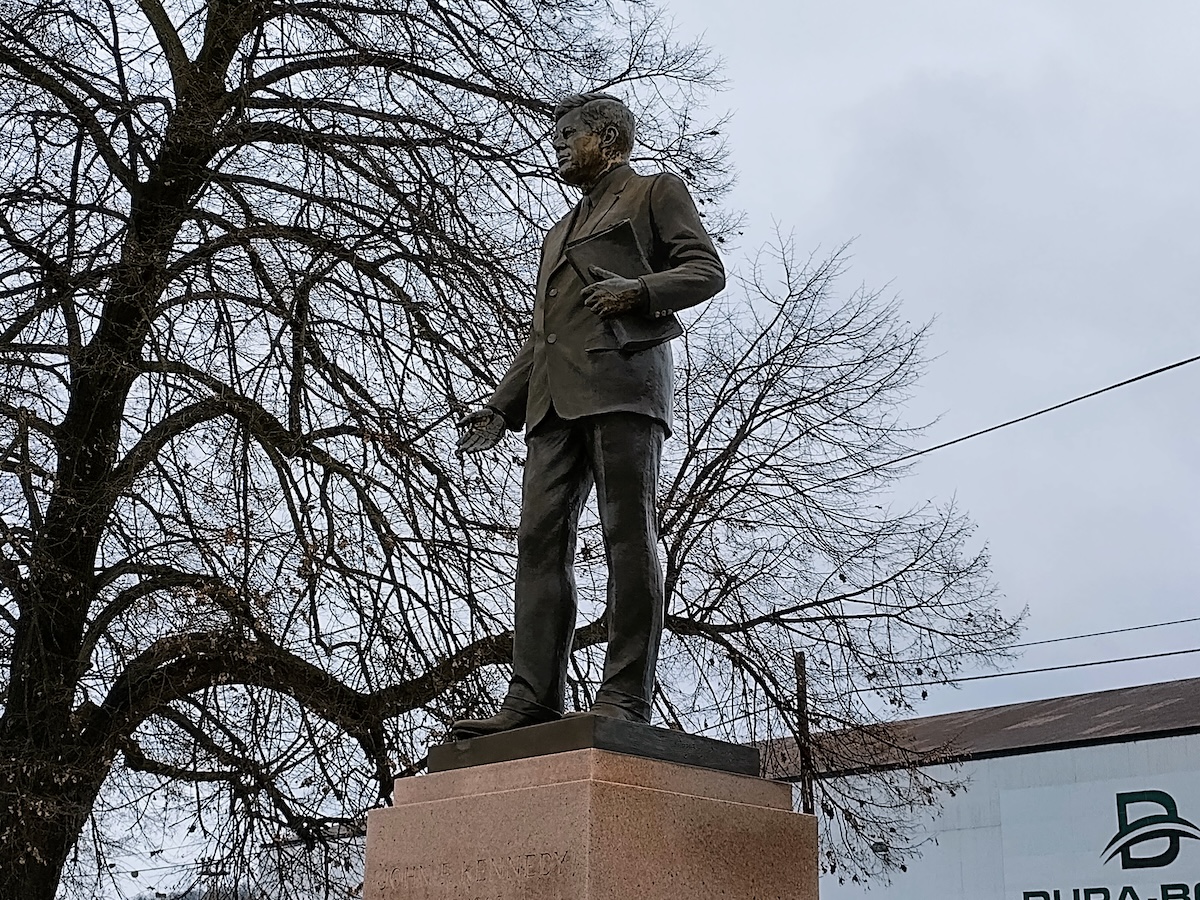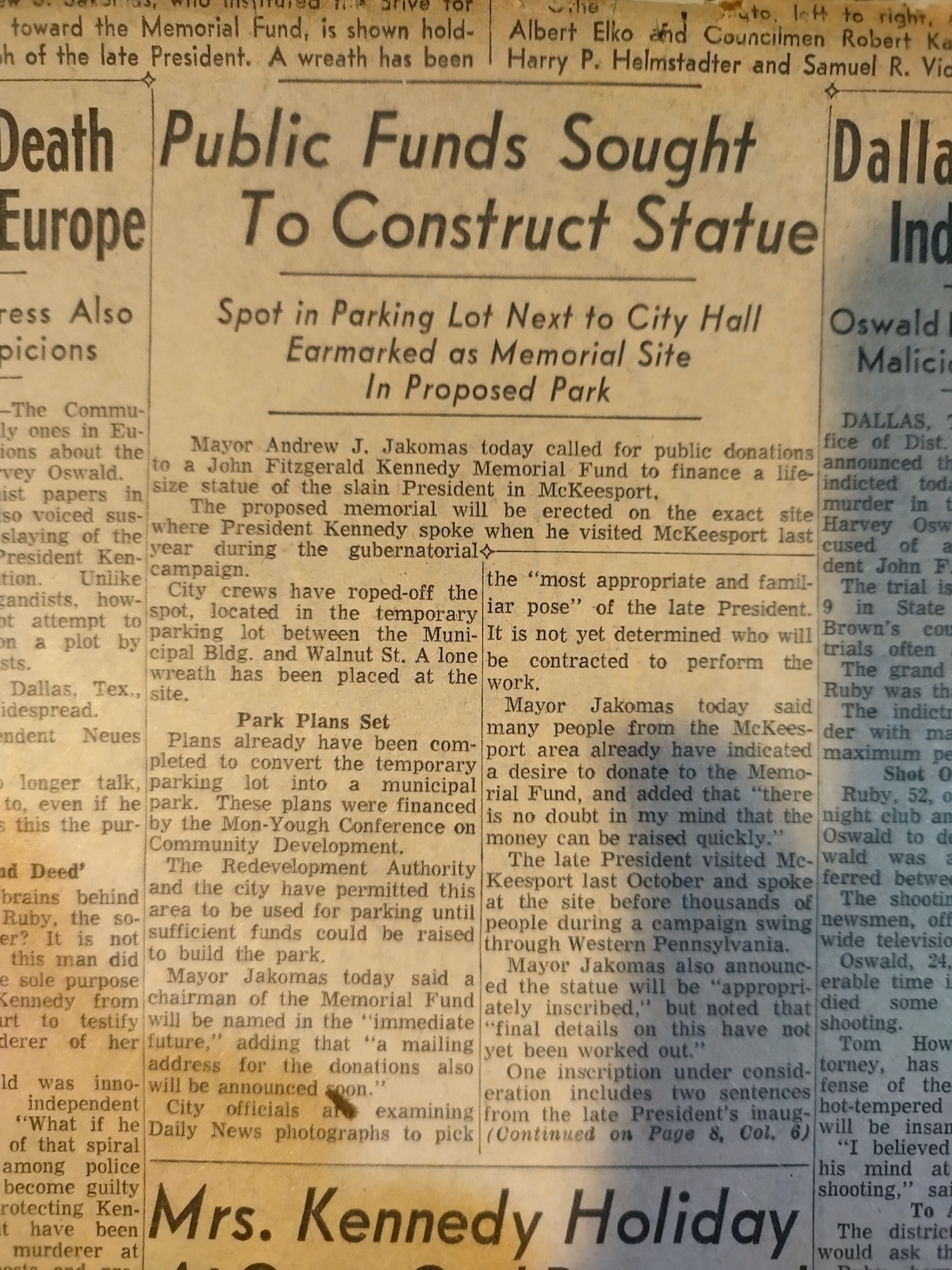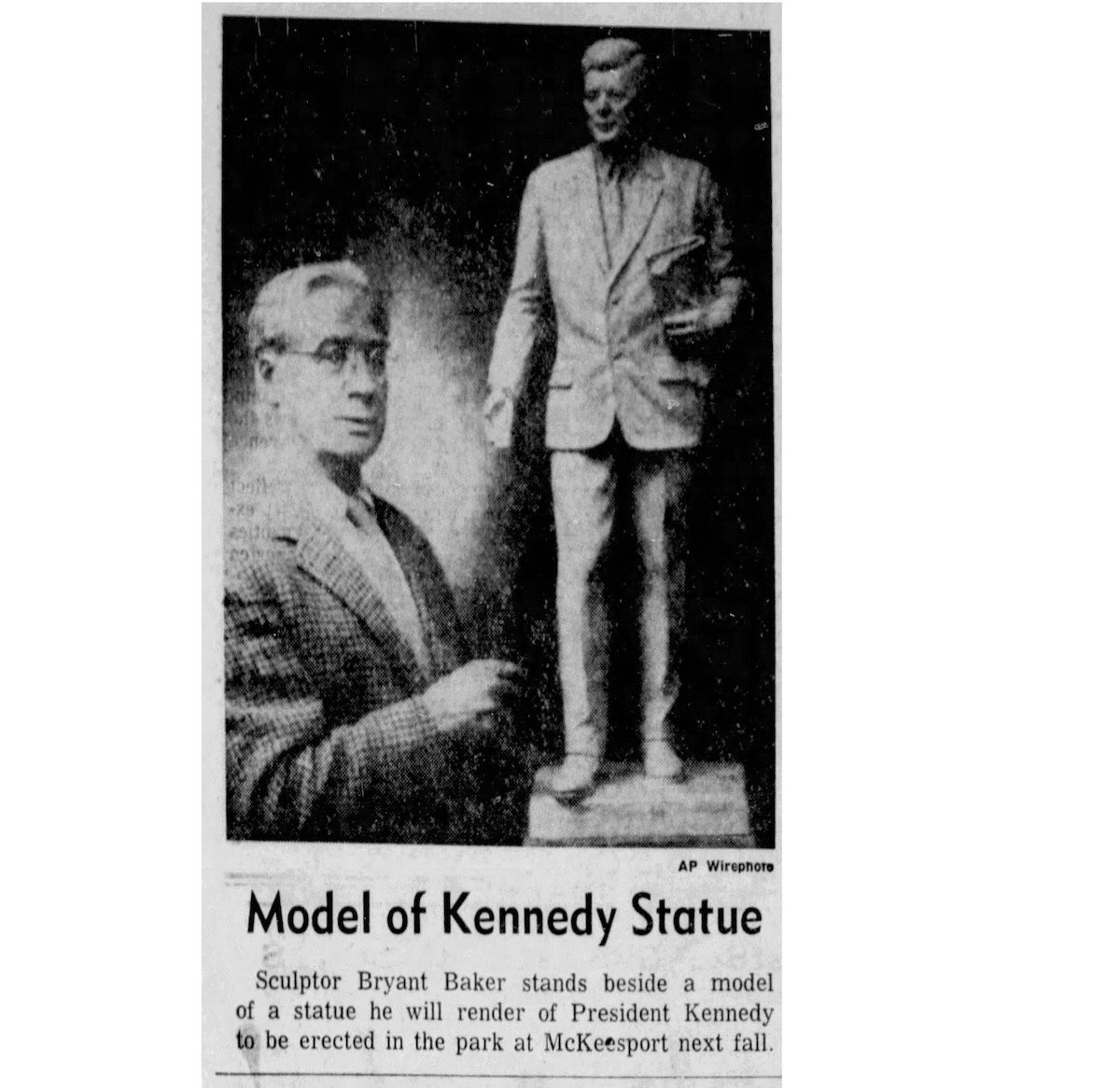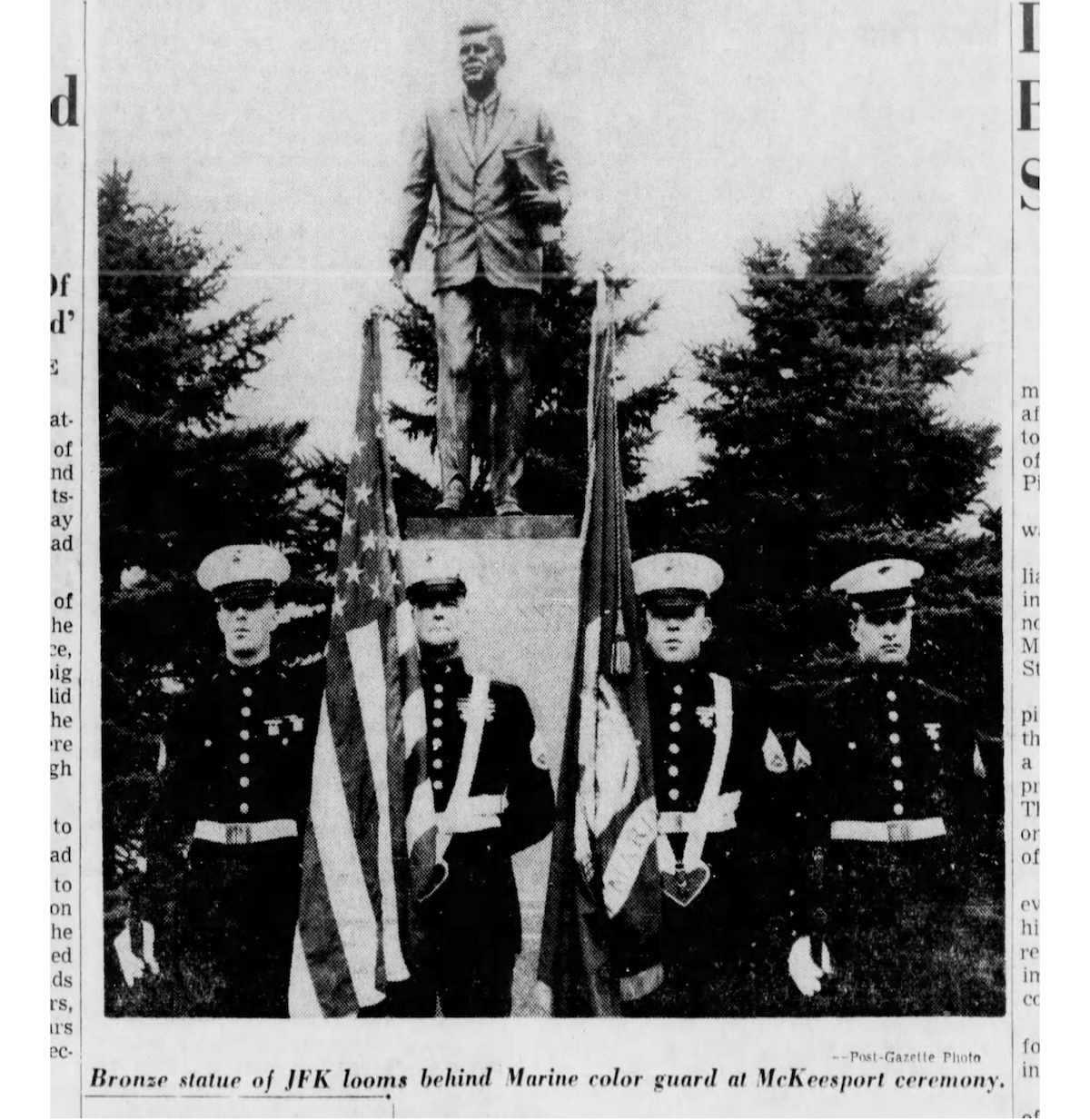(Advertisement)
Tube City Community Media Inc. is seeking freelance writers to help cover city council, news and feature stories in McKeesport, Duquesne, White Oak and the neighboring communities. High school and college students seeking work experience are encouraged to apply; we are willing to work with students who need credit toward class assignments. Please send cover letter, resume, two writing samples and the name of a reference (an employer, supervisor, teacher, etc. -- not a relative) to tubecitytiger@gmail.com.
Ads start at $1 per day, minimum seven days.
JFK Statue Was Last Major Work of Famed Sculptor
City’s bronze, unveiled one year after assassination, attracted worldwide attention
By Jason Togyer
The Tube City Almanac
November 23, 2023
Posted in: History
© Tube City Community Media Inc., all rights reserved, except for archival images

McKeesport Mayor Andrew “Greeky” Jakomas (second from left) marks the spot of a new memorial for slain President John F. Kennedy, along with Councilmen Albert Elko, Robert Kaplan, Harold Blid, Harry P. Helmstadter and Sam Vidnovic. (McKeesport Daily News photo/Tube City Almanac collection)

(Tube City Almanac photo)
The assassination of President John F. Kennedy brought life to a halt across the United States. And McKeesport, like cities everywhere, acutely felt the grief.
Unlike many other communities, however, the Tube City’s civic leaders directed their pain into positive action. Before Kennedy’s funeral was complete, McKeesport Mayor Andrew “Greeky” Jakomas and leading citizens had launched a fund-raising drive to erect a statue of the slain president on Lysle Boulevard.
One year later — after raising the modern equivalent of $375,000 — McKeesport unveiled what was reportedly the world’s first statue of John F. Kennedy, along Lysle Boulevard, where it still stands today. It is also the last major work of world renowned artist Bryant Baker, who served as a sculptor of kings and presidents for a half-century.

President John F. Kennedy visits with a young boy during a congressional campaign rally at the municipal parking lot at City Hall in McKeesport, Pa., Oct. 13, 1962. (Official White House photo via JFK Library.)
On a crisp, sunny autumn day in McKeesport in 1962, a crowd estimated at 25,000 people had pushed into the intersection of Lysle Boulevard and Walnut Street to hear Kennedy, 45, speak from a platform next to the P&LE railroad tracks.
Screaming crowds of teen-agers who wanted to touch the handsome, young president pushed forward, smashing through a wooden railing and alarming McKeesport police, Allegheny County sheriff’s deputies and Secret Service agents, who worked hard to maintain order. Three children were hurt (none seriously) in the stampede.
In many ways, the reception was not unlike Kennedy’s enthusiastic welcome in Dallas on the morning of Nov. 22, 1963.
Kennedy had come to McKeesport on Oct. 13, 1962, for purely political reasons, speaking on behalf of Democratic candidates, including Richardson Dilworth, who was running an ultimately doomed campaign for governor of Pennsylvania.
“A half-hour before President Kennedy arrived, the throng politely tolerated short speeches from politicians introduced by Mayor Andrew J. Jakomas,” the Pittsburgh Press reported. “As Gov. David L. Lawrence stepped to the microphone, the throng began a low moan. He finished quickly.”
Then Dilworth stepped to the microphone, and “the moan from the audience began to increase.”
But when U.S. Sen. Joseph Clark introduced JFK, the Press reported, “the yell of approval from the crowd” was as if “he had just carried the ball across the goal line for the winning touchdown.”
Dilworth went onto get trounced by Republican Bill Scranton in the November 1962 election, but Kennedy was a winner in McKeesport that October afternoon during what UPI called a “hard day of campaigning” that also included stops in Pittsburgh, Monessen and Washington, Pa.
He began by recalling his first visit to the city in 1947, when, as a rookie congressman from Massachusetts, he had debated another rookie congressman, Richard Nixon of California. The topic of that debate – held at the Penn-McKee Hotel — was the Taft-Hartley Act, which put restrictions on labor union activities.
“He won that one,” Kennedy said of Nixon, smiling at the crowd, “and then we both went onto other things.”
(Hear Kennedy’s speech in McKeesport.)

(Tube City Almanac collection)
The fund-drive to erect a statue of Kennedy was announced in the Daily News on Tuesday afternoon, Nov. 26, 1963. Plans were already underway to convert the gravel parking lot — owned by McKeesport’s Redevelopment Authority — into a municipal park.
Jakomas vowed that the fundraising committee would borrow photos from the Daily News of JFK’s 1962 visit to pick the “‘most appropriate and familiar pose’ of the late President.”
“This is the least the City of McKeesport can give for a man who gave so much for his country,” Jakomas said.
Not everyone was pleased. “I wonder if this is what John F. Kennedy would have wanted,” asked a Glassport resident in a letter to the editor. “Why not use that money to create some type of student scholarship fund for needy students. Wouldn’t this be a much more fitting memorial for our late president?”
Two weeks later, Jakomas announced the name of the sculptor who had been granted the city’s commission — world-renowned artist Bryant Baker.

Born in London, England, in 1881, Baker’s father and grandfather had both been sculptors who had worked on Westminster Abbey. The younger Baker apprenticed with his father, then studied art at the Royal Academy. By 1910, he had been commissioned by the royal family to sculpt a bust of Edward VII upon the monarch’s death.
Baker was then commissioned to craft a life-size, full-length statue of the king, which was unveiled by King George V and Queen Mary in 1912. The monument, which stands outside of a hospital in Huddersfield, West Yorkshire, is now a U.K. historic monument.
In 1916, Baker re-located to the United States, where his reputation as the sculptor of kings had preceded them. He was soon commissioned to craft busts of William Howard Taft, Grover Cleveland, Millard Fillmore and other U.S. presidents, including George Washington.
In 1930, Baker took on a commission for Ponca City, Fla., that he later considered his life’s work — “Pioneer Woman,” donated by millionaire oil tycoon E.W. Marland. Models of the monument toured the United States (including Pittsburgh), causing a sensation.
Baker was 82 years old and winding down his illustrious career when McKeesport officials called him in his New York City studio. The commission of the world’s first statue of the slain president was a worldwide news story.

In less than three months, Baker had crafted a clay model. By the one-year-anniversary of Kennedy’s assassination, the nine-foot-tall finished statue was complete and delivered to McKeesport and placed on a plinth of pink Tennessee marble.
The final cost, raised from donations, was $38,000.
“For an octogenarian, (Baker) has set an example of speed and vigor which younger men in the field must envy,” wrote the U.K.’s Daily Telegraph, which added that Baker expected the Kennedy statue to be his last large work. “At 83, he is somewhat chary of accepting further commissions,” the newspaper reported.
“It was not easy to make a fine statue of a modern young man in modern clothes, but I feel I have done a good job,” Baker told his hometown newspaper, the Huddersfield Daily Examiner.
“He was a very difficult man to do, because he was a man of so many moods,” Baker told the Buffalo, N.Y., News two years later. “I studied hundreds of photographs. His expression is serious because he was quite a serious young man.”
Baker posed Kennedy so that his right hand was extended in friendship, as if to offer a handshake. In his left hand, Kennedy is carrying a sheaf of papers — his unfinished work, several writers remarked at the time.
The statue was unveiled to McKeesporters on Sunday, Nov. 22, 1964. But a formal dedication ceremony was slated for the following February, where the president’s brother, U.S. Sen. Robert F. Kennedy of New York, was scheduled to be the featured speaker.

At 10 a.m. on Feb. 8, despite pouring rain, more than 5,000 people pushed into the plaza at the corner of Lysle Boulevard and Walnut Street. A U.S. Marine Corps honor guard took up its post in front of the statue.
But RFK never arrived. The poor weather had closed down both the Greater Pittsburgh Airport as well as airports in Washington, D.C., and the senator’s brother was forced to send his regrets.
Also absent was Baker, who was too ill to travel.
Instead, the featured speaker was a man well-known as one of Western Pennsylvania’s finest orators and legal minds. State Supreme Court Justice Michael Musmanno called Kennedy “an Alexander of a statesman and an Olympian god in appearance, who carried the sword of truth.”
Pittsburgh Mayor Joseph M. Barr and Allegheny County Commissioner William D. McClelland also attended.
Despite RFK’s absence, Jakomas pronounced himself satisfied with the dedication ceremony, and felt that the Kennedy statue was a fitting memorial to the late president. “We of McKeesport and this area have a strong feeling of kinship with him,” Jakomas said. “If he was not one of us — he was at least a part of us.”
McKeesport’s Kennedy statue turned out to be one of Baker’s last major works, although he did make a copy of it — a head-and-shoulders bust only — to be displayed at the Buffalo, N.Y., city hall. Baker died in 1970.

(Tube City Almanac photo)
The statue itself has become a traditional spot for many aspiring politicians during their own campaigns, including Michael Dukakis in 1988, Bill Clinton and Al Gore in 1992, and then-state Rep. Austin Davis when he announced his run for lieutenant governor in 2022.
Not everyone had a reception as warm as Kennedy’s, though. When then-U.S. Rep. Rick Santorum announced plans to run for the U.S. Senate in 1994, the crowd heckled him with shouts of “Go home, Rick” and carried signs labeling the Mt. Lebanon Republican as “Champagne Rick.”
Unlike Dilworth in 1962, who knew when to exit the stage, Santorum pressed on. “If John Kennedy were alive today, he would be 76 years old and he would say, ‘It’s time to pass the torch,’” Santorum said.
That prompted someone in the crowd to yell, “You ain’t no John Kennedy!”
Jason Togyer is the editor of Tube City Almanac and serves as volunteer executive director of Tube City Community Media Inc. He may be reached at jtogyer@gmail.com.
Originally published November 23, 2023.
In other news:
"One Hurt in Duquesne …" || "Heritage Hill Park Ge…"
 TM
TM